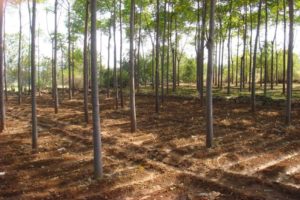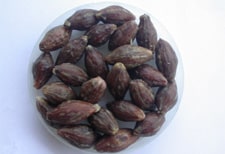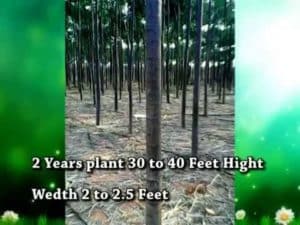Malabar Neem Farming Information Guide:
The following article explains Malabar Neem Farming in India.

Introduction:
Malabar Neem originates from the Meliaceae family and is an indigenous species of tree to India, South East Asia, and Australia, where it has been cultivated as a source of firewood. The tree can be cultivated in all types of soil and requiring a low supply of water. Malabar Neem has the unique feature of growing to 40 feet within 2 years from planting and can be mechanically pruned and harvested. Malabar Neem is a species belonging to the Neem family. This tree is known for its fast growth. In recent times the farmers around Karnataka, Tamil Nadu, Andhra Pradesh & Kerala have found the utility of this tree both as a low-grade timber and also a very useful wood for the plywood industry. Under irrigated conditions, this tree can be harvested at the end of the 5th year for both timber and plywood purpose.
Other names of Malabar Neem:
Marathi – kuriaput;
Gujarathi – Kadukajar;
Telugu. – Munnatikaraks;
Tamil – Malai vembu;
Kannada – Hebbevtl; Karibvam;
Malayalam – Malavembu;
Oriya – Batra.
It is also commonly called “Melia Dubia”.
Uses of Malabar Neem:
The wood is used for packing cases, cigar boxes, ceiling planks, building purposes, agricultural implements, pencils, matchboxes, splints, and Kattamarams. In Ceylon, it is employed for outriggers of boats. It is suitable for musical instruments, tea boxes, and plyboard. It is good fuelwood (Calorific value, 5.043 – 5,176 cal.).
The fruit of the plant is bitter. It is considered anthelmintic. It gives positive tests with alkaloid reagents.
Characteristics of Malabar Neem:
A height of 20.m with a spreading crown and a cylindrical straight bole of 9 m length and 1.2 – 1.5 m girth. The bark is dark brown, exfoliating in thin, narrow strips with broad, shallow, longitudinal cracks. Leaves bi-pinnate or occasionally tri-pinnate. Leaflets ovate – Lanceolate to ovate-round, entire or crenulate; flowers greenish-white, fragrant, intense panicles; fruit an ovoid or ellipsoid drupe with 5 or fewer seeds.
Soil requirement for Malabar Neem Farming:
It grows on a variety of soils. However deep fertile sandy loam soils show optimum growth, while shallow gravelly soils show stunt growth. The tree is a light demander, the seedling is suppressed under shade. Seedlings tolerate some frost but severe frost kills them. It is susceptible to damage by fires and sapling suffers from browsing.
Read this: RAS Fish Farming In India.
Propagation in Malabar Neem Farming:
It can be raised either by direct sowing or planting in the nursery for raising seedlings or stumps. Direct sowing is recorded to give poorer results than the planting of samplings or stumps; the latter is considered the best.
Read this: Malabar Neem Project Report, Cost and Profit details.
Seed treatment in Malabar Neem Farming:
Seeds are collected from ripened fruits (Jan – Feb) by rubbing, washing, and drying and are stored in sealed tins. The germinability of the seed is less than 25%. In the nursery, the seeds are sown in raised nursery beds. The best seed treatment is treating the seeds with cow dung solution for one day. Then the treated seeds are sown over the raised nursery bed. It takes one or two months for the seeds to germinate. Irrigation should be done regularly. The seedling takes 6 months to complete its nursery stage.

Spacing in Malabar Neem Farming:
Six to nine months old seedlings can be planted at a spacing of 3 X 3m or 3 X 4m. Annual pruning is done to get the straight cylindrical boles.
Irrigation in Malabar Neem Farming:
The tree responds well to irrigation at once every 10 – 15 days during the non-rainy season.
Fertilizer requirements in Malabar Neem Farming:
Application of N, P, K mixture of 25 -50 g per tree, two times a year helps to augment the growth. The fertilizer requirements can be scheduled on a need basis depending on the growth and development of the tree.
Insects and Pest in Malabar Farming:
Defoliators, leaf miners, and sapsuckers are recorded along with several wood borers. Ganoderma lucidum causes root rot in high rainfall areas and Corticium salmonicolor causes stem and twig canker.
Malabar Neem wood characteristics:
The sapwood is greyish white; heartwood light pink to light red turning pale russet brown on aging. It is lustrous with a dry feel, very light (SPL gr- 0.33; wt – 21 Ib. /cu ft.) straight-grained and coarse, and somewhat uneven – textured. The timber is not durable in exposed positions but moderately so undercover. It is not so strong and durable as neem. It seasons well if logs are converted in a green state. If left long, the log is liable to develop end–splitting and discoloration. The best method of dealing with the timber is to convert the logs immediately after felling and to open – stack sawn material, preferably undercover, to avoid grey stain.

Marketing of Malabar Neem:
The Malabar neem wood can be sold for the match and veneer industry. The tree with a minimum size of 16inches girth is saleable at the minimum rate of Rs 2000 per tonne for the watch industry and for the veneer industry, the market rate is a little higher.
Bottom Line:
Malabar Neem Farming is picking up due to its fast growth and huge demand for this wood. Huge Profits are achievable in shorter periods.
In case if you are interested in this: How To Grow Organic Lettuce.
- Economical Aquaculture: A Guide to Low-Budget Fish Farming
- 15 Common Planting Errors That Can Doom Your Fruit Trees
- How to Make Houseplants Bushy: Effective Tips and Ideas
- Innovative Strategies for Boosting Coconut Pollination and Yield
- Pollination Strategies for Maximum Pumpkin Yield
- The Complete Guide to Chicken Fattening: Strategies for Maximum Growth
- Natural Solutions for Tulip Problems: 100% Effective Remedies for Leaf and Bulb-Related Issues
- Revolutionizing Citrus Preservation: Towards a Healthier, Greener Future
- Natural Solutions for Peony Leaf and Flower Problems: 100% Effective Remedies
- Maximizing Profits with Avocado Contract Farming in India: A Comprehensive Guide
- Natural Solutions for Hydrangea Problems: 100% Effective Remedies for Leaf and Flowers
- The Ultimate Guide to Choosing the Perfect Foliage Friend: Bringing Life Indoors
- From Sunlight to Sustainability: 15 Ways to Use Solar Technology in Agriculture
- The Ultimate Guide to Dong Tao Chicken: Exploring from History to Raising
- The Eco-Friendly Makeover: How to Convert Your Unused Swimming Pool into a Fish Pond
- Mastering the Art of Delaware Chicken Farming: Essentials for Healthy Backyard Flocks
- 20 Best Homemade Fertilizers for Money Plant: DIY Recipes and Application Methods
- How to Craft a Comprehensive Free-Range Chicken Farming Business Plan
- Brighten Your Flock: Raising Easter Egger Chickens for Beauty and Bounty
- How to Optimize Your Poultry Egg Farm Business Plan with These Strategies
- Subsidy for Spirulina Cultivation: How Indian Government Schemes Encouraging Spirulina Farmers
- Ultimate Guide to Raising Dominique Chickens: Breeding, Feeding, Egg-Production, and Care
- Mastering the Art of Raising Jersey Giant Chickens: Care, Feeding, and More
- Ultimate Guide to Raising Legbar Chickens: Breeding, Farming Practices, Diet, Egg-Production
- How to Raise Welsummer Chickens: A Comprehensive Guide for Beginners
- How to Protect Indoor Plants in Winter: A Comprehensive Guide
- Ultimate Guide to Grow Bag Gardening: Tips, Tricks, and Planting Ideas for Urban Gardeners
I m interested to Malabar neem project
Can u give me contacnumber for helping malaba neem farming
We don’t have personal support. However, to read the project report of malabar neem : Read Here,
I have just planted 240 media Dubai with. A spacing of 18×18 feet. Please suggest intercrop . I am planning aracanut or lemon. Is it okay. I have water in plenty.
Lemon would be best.
Can Malabar neem farming be done in Chattisgarh. Is it suitable?
Yes..You should have good irrigation facility with well drained soil.
I am interested in cultivating malabar neem with cocoa as intecrop. is it a good combination or should i consider some other plant as intercrop. Please let me know if this combination has already been tried and results have been seen. An information and input on this aspect are highly appreciated.
I am also interested in forming malbar neem.
Please tell how could be it accomplished .Get details from purchasing of plants to every details.
Thanking you
Hello, can you upload these Malabar Neem plantation report in PDF form please.
Hello, can you please let us know Malbar Neem consultants near Nellore and Tirupati area.
so that we will contact them.
Hi,
how many malabar neem plants can be planted when it is planted as an intercrop for sandalwood?
also can you suggest me the best intercrop that can be planted for sandalwood for better profits?
Is the soil of purnea Bihar suitable for Malabar neem? Kindly let me know.
Thanks and regards.
Hello Sir,
I am from Bihar and want to do Malabar neem farming in my fields. I need your complete guidance for this.
Can malawar neem be planted in Dhanbad, Jharkhand. Please advice near by sellers and also complete deails about plantation.
Hi,
Can I plant malabar neem in haryana ? do we have any buyers in haryana for malabar neem near Yamunanagar ?
Regards
Could Malabar neem tree grow in Jhansi District of Uttar Pradesh.
yeah You can Grow easily, it will be Harvesting after app. 6-7Years (because the atmosphere reason)
Hello sir my farm in Betul District M.P. Anyone please suggest me where to buy plants.
ఈ మొక్కలు ఎక్కడ దొరుకుతాయో నాకు సమాచారం కావలెను ఫోన్ నెంబరు ఇవ్వగలరు